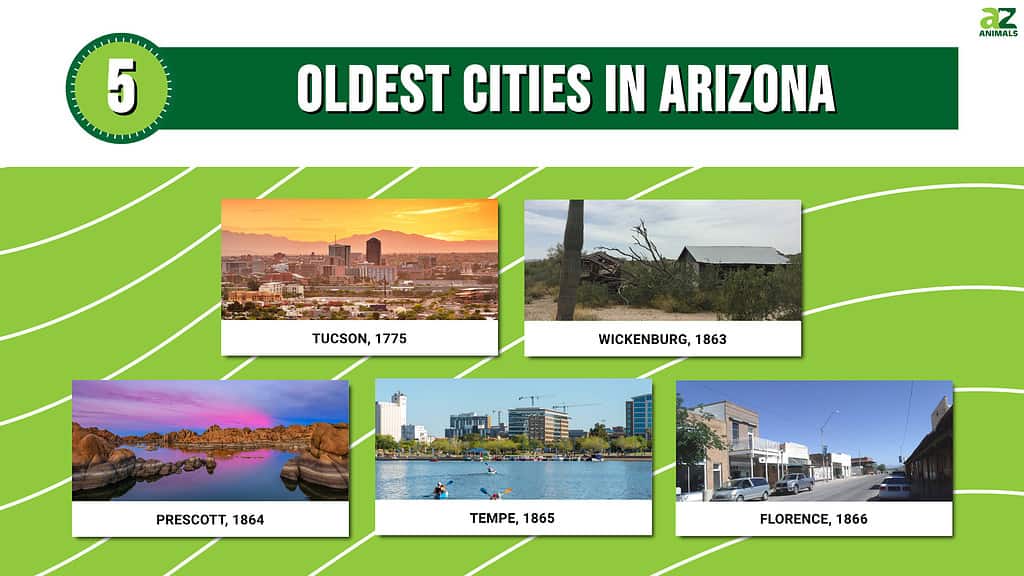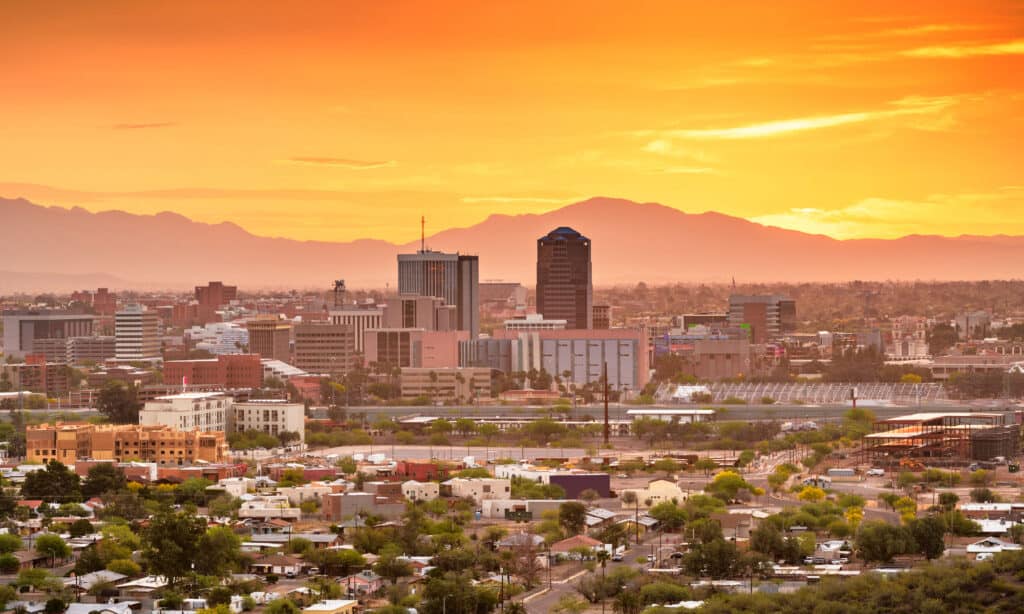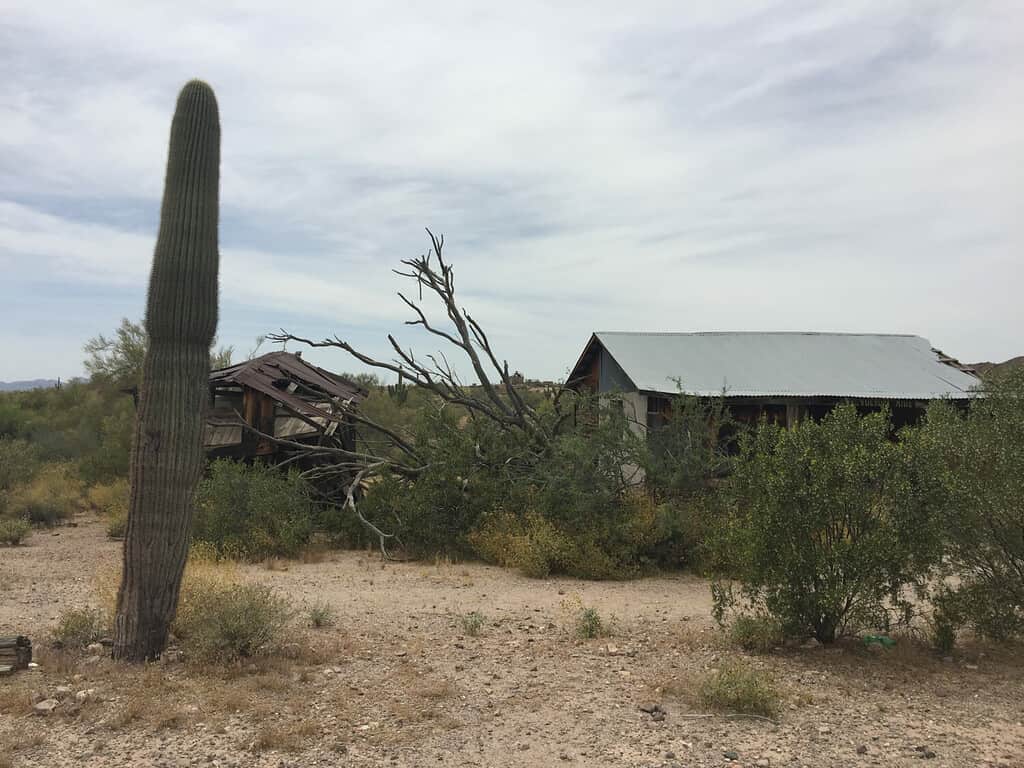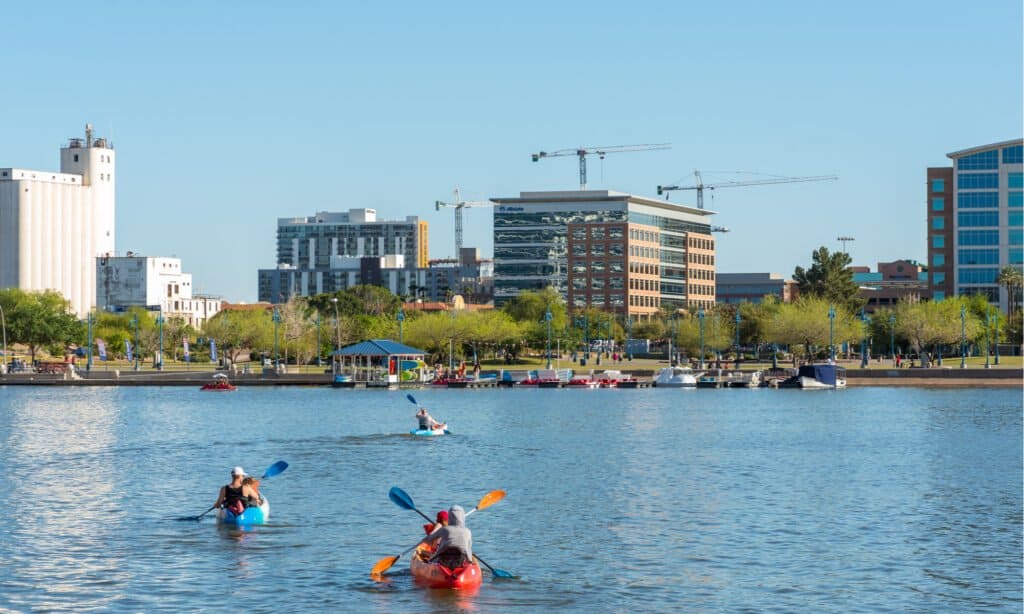Arizona is full of contrasts and its history goes back to prehistoric times. You can still see the ruins of some of the earliest settlements still standing today. Arizona is woven into the American Old West heritage, with ghost towns, mines, old railroads, and sites of long-ago battles.
Large areas have been developed into farms and ranch land. However, a lot of the natural landscape hasn’t changed much for thousands of years. The scenery includes layered canyon walls, thirsty deserts, towering pine forests, and snow-capped mountains. But Arizona is also home to modern cities like Phoenix and Tucson, which are hubs of commerce, transportation, and culture. Explore Arizona with us, as we discover the oldest cities in the state, along with what you can do there.

Scenes like this are quintessential “Arizona,” but so are modern cities like Phoenix.
©Mark Baldwin/Shutterstock.com
Oh, and by the way, definitions of “city” vary widely. We’ve chosen to include just places with a population of at least 1,500 people as of the 2020 census. You won’t find any ghost towns on this list, just friendly places you’ll want to consider for your next vacation.

1. Tucson, 1775
Tucson is the second largest city in Arizona, after Phoenix. Its current population is over 540,000. The Mexican border is just 60 miles away, with Nogales, Mexico on the other side. So if you visit, take your passport!
Tucson was originally started as a Spanish military fort. It was not part of the United States territory won during the Mexican War. It was added later as part of the Gadsden Purchase of 1853. Officials made this agreement to facilitate the building of an American railroad line from Texas to California.
No matter what your hobbies or interests are, modern Tucson has something for you. Annual events like the Tucson Gem & Mineral Show (February) and the Tucson Festival of Books (March) attract many people. The Tucson Folk Festival (May) and the Fourth Avenue Street Fair (March and December) are also popular events. Additionally, the Tucson Rodeo occurs each February. The city is home to several museums overflowing with local and world history, art, culture, and technology. Tucson has over 120 parks and it has been given a gold rating by the League of American Bicyclists. The annual El Tour de Tucson race has attracted up to 10,000 participants from all over the world. The great climate of the area makes it an ideal place to bike, run, or hike all year round.

Tucson is an ideal location to bike, all year round.
©iStock.com/Credit:Sean Pavone
2. Wickenburg, 1863
Wickenburg got started in 1863 after the discovery of gold in the area. You can still see the remains of the Vulture Gold Mine, where over $30 million in gold was extracted. Ranchers and farmers followed, and Wickenburg began to prosper as a supply post for the mines and the army. Relations with the local indigenous people were violent with massacres on both sides, and the town went through battles with outlaws, droughts and floods, and mine closures as mineral deposits were exhausted. The town managed to survive, though, and is growing today, having gained about 1,000 people from 2010-2020 and now numbering about 7,500.
Wickenburg is well worth visiting today. You need to see the Desert Caballeros Western Museum to see what a general store and a typical home looked like in the old west. You can fish at the Hassayampa River Preserve. Vulture Peak Trail is a good choice for hiking or mountain biking. There are also equestrian trails in the area, and considering how large horses figured in the local history, that seems really appropriate way to see the area and build some memories. Gramma Lizards is a quirky little shop with original paintings and hand-painted furniture where you can find a one-of-a-kind keepsake of your Arizona vacation. And if you’re into golf, there are a couple of beautiful courses in the area. It’s a unique experience to golf on lush well-watered grass at the base of rugged desert foothills with beautiful rock formations and desert plants.

The Vulture Gold Mine is one of the historic sites you can see near Wickenburg, Arizona.
©Thomas Trompeter/Shutterstock.com
3. Prescott, 1864
Prescott was the territorial capital of Arizona before being replaced by Phoenix in 1889. Today it’s a city of about 46,000 people. Historically, it was a gold and silver mining town and the site of Fort Whipple, a U.S. army base for campaigns against local indigenous people such as the Yavapai and the Apache. It was a Wild West town in every sense of the word and was even the home of Doc Holliday and Virgil Earp (Wyatt’s brother) of the famous gunfight at the O.K. Corral.
One of the main draws of Prescott for visitors is the “World’s Oldest Rodeo,” which has operated since 1888 and now draws 35,000 tourists a year. Prescott is a good place to learn about Native American culture, then and now, as the Yavapai-Prescott Indian Tribe reservation partially overlaps the borders of the city. You can see a number of different buildings that are on the Historical Register. If by chance you have a teenager who is getting tired of all this cowboy-and-Indian history, tell them that Prescott has a thriving punk scene. Bueno, Life in Pictures, and Hour of the Wolf are some of the bands that launched from here, and punk bands from across the country area include Prescott on their tour itineraries.

Granite Dells is a spectacular site near Prescott.
©Nick Fox/Shutterstock.com
4. Tempe, 1865
With a current population of 180,500, Tempe is a major city in Arizona and the location of the main campus of Arizona State University. A pioneer suggested the name of the city after thinking that the Salt River Valley at the base of a 300-foot-tall butte in the area reminded him of the Vale of Tempe near Mount Olympus in Greece. Tempe was near the site of a main ferry crossing of the river and an irrigation canal to provide water for local grain production. In modern times, it has benefited from the growth of neighboring Phoenix, acting as a bedroom community for the larger city.
Tempe has a major league ice hockey team, the Arizona Coyotes, who play at Mullett Arena. The Los Angeles Angels have spring training at Tempe Diablo Stadium. If you want to get active yourself, Tempe Town Lake draws nearly 3 million people a year for kayaking and other water-based recreation. Tempe Butte is located at the ASU campus downtown and has hiking and cycling trails. Music lovers might want to check out the dive-bar Yucca Tap Room, which hosts nightly live music. Tempe was a popular center for alternative music in the 1980s and 90s. And of course for culture and history buffs, this major Arizona city has all the museums and art venues your heart could desire.

Kayaking across Tempe Town Lake in Tempe, Arizona is a favorite pastime.
©Gregory E. Clifford/Shutterstock.com
5. Florence, 1866
Florence, a city of 27,000 people, is located 63 miles southeast of Phoenix. It is on the south bank of the Gila River, which was the former border between the United States and Mexico before the Gadsden Purchase transferred a large territory to the U.S., including the area that is today Florence. The settlement was originally started by a Civil War veteran at a location in the new territory that had an easy river crossing point. Nine years later silver was discovered nearby, bringing a flood of miners and causing the town to grow as a logistic hub.
This is the place to go if you like historic buildings, as it has 25 buildings listed on the National Register of Historic Places. Touring the area, you’ll hear about the Tunnel Saloon shootout of 1888 and the trials of three notorious female murderers, two of which led to national debates about capital punishment. And finally, you might enjoy touring the beautiful St. Anthony’s Greek Orthodox Monastery, a working monastery established in 1995 in the Sonoran desert near Florence.

St. Anthony’s Greek Orthodox Monastery is a working monastery in the Sonoran Desert near Florence, Arizona.
©Joseph Creamer/Shutterstock.com
Pack Your Bags for Arizona
Maybe you wonder why Phoenix isn’t on our list. Incorporated in 1881, Phoenix is still a spring chicken compared to the five oldest cities in Arizona. But these five give you a taste of what this state has to offer. History, museums, international and indigenous cultures, outdoor activities for all ages and athletic abilities, events and music venues for a variety of interests and tastes. Best of all, at least in the southern part of the state, you can enjoy a lot of these activities all year round due to Arizona’s dry, sunny climate. It’s one of the reasons Arizona has been drawing new residents as well as visitors for over a century. We bet now it’s calling you, too.
Summary Of The 5 Oldest Cities in Arizona
| Rank | City | Date Founded |
|---|---|---|
| 1 | Tucson | 1775 |
| 2 | Wickenburg | 1863 |
| 3 | Prescott | 1864 |
| 4 | Tempe | 1865 |
| 5 | Florence | 1866 |
The photo featured at the top of this post is © iStock.com/pmphoto
Thank you for reading! Have some feedback for us? Contact the AZ Animals editorial team.







